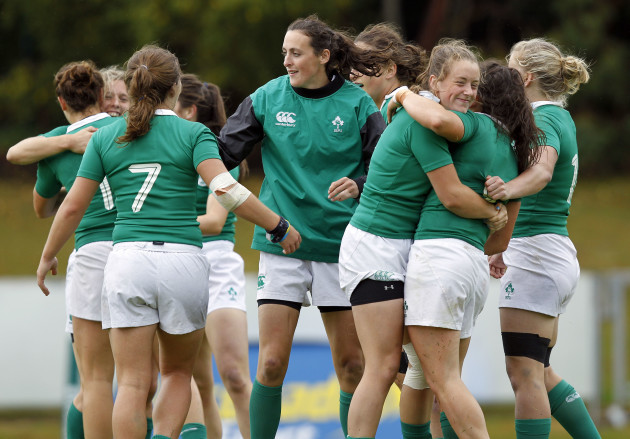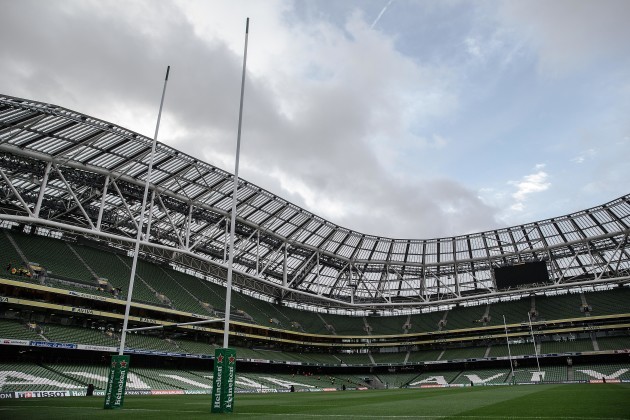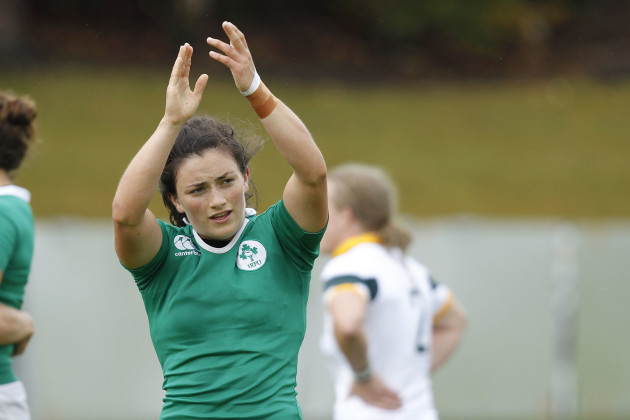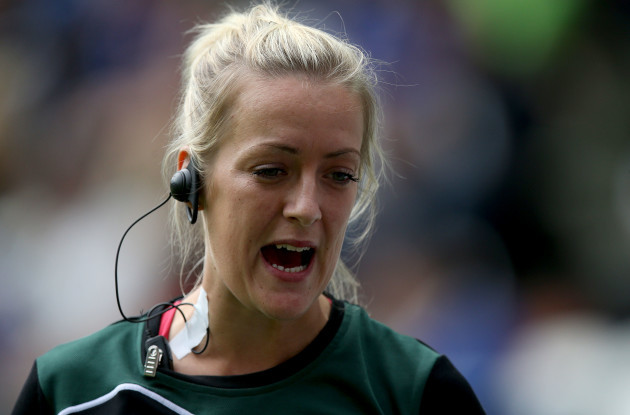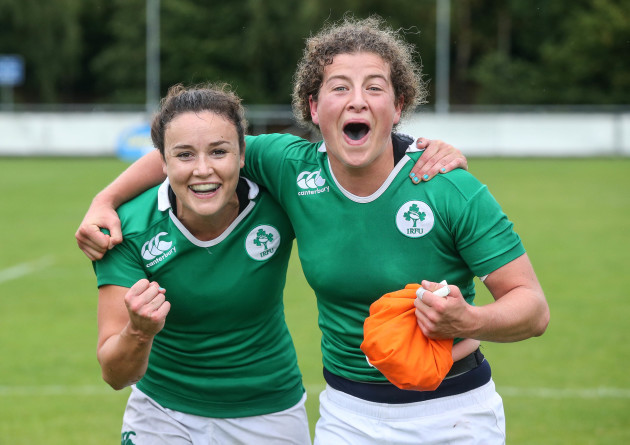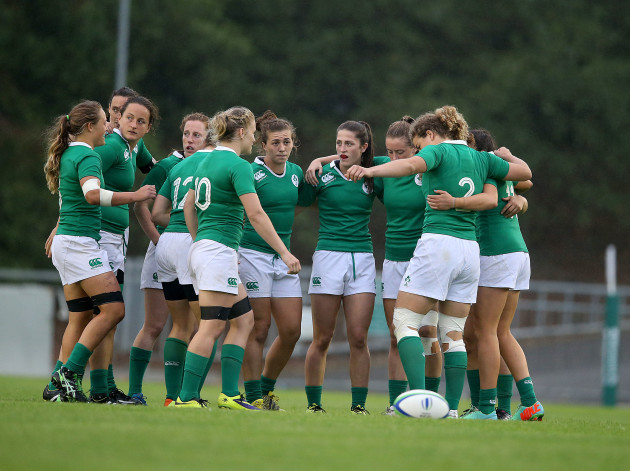IN ONE OF the beautiful Victorian houses on Lansdowne Road, Ireland’s rugby sevens Olympic dream is alive and kicking.
Things were a little quieter this week, however, with the Ireland women’s sevens squad currently in Australia ahead of this weekend’s three-Test series.
Following seven days of intense training in world-class facilities in Sydney, Anthony Eddy’s side face the Australians in the first of those Tests at 12.56am Irish time on Sunday. At the conclusion of this trip to Australia, the Irish squad will fly on to São Paulo for the next leg of the World Sevens Series.
Ireland’s head of strength and conditioning, Marian Earls, jokes that the apparent jet-setting life of the sevens circuit “sounds more glamorous than it is,” but there are certainly worse ways to spend February.
Visiting new cities is appealing, but there is serious business at hand for the Irish squad. After finishing last in the Dubai leg of the World Series – on their return to that stage after a season’s absence – major improvement is needed in São Paulo.
Ireland must finish this season in the top eight of the series in order to retain their place on the circuit, while the final Olympic qualifying tournament in Dublin in June looms large in the background.
Only the winner of that repechage in UCD will advance to the summer games in Rio. With the IRFU having invested more than €2 million into their goal of having the women’s sevens team take part in the Olympics, there is plenty on the line.
Last week, The42 spent a training day with Eddy and his squad before they flew out to Australia.
HQ
The women’s squad moved into their Lansdowne Road headquarters last October, having previously based themselves out of DCU. The facilities at the university were “brilliant,” according to manager Gillian McDarby, but this new location is more suited to their purpose.
A large, open-plan team room fills much of the first floor and is kitted out with a TV, couches and all sorts of recovery aids like foam rollers and tera bands. It serves as a dining room when the 21-player squad get catered meals two evenings a week. Next door is the kitchen where players store and prepare food on training days.
Upstairs are offices for IRFU director of women’s and sevens rugby Eddy, squad manager Gillian McDarby and others, as well as a team meeting room which houses a number of MacBooks for video analysis work. On the top floor of the building is a large physio room, with an adjoining ‘rehab room’.
When not in competition, the Irish squad have heavy training days on Mondays, Tuesdays, Thursdays and Fridays, with a lighter schedule at base on Wednesdays still involving skills work, physio, rehab, analysis and individual meetings.
In the shadows of the Aviva Stadium, the red-brick building on Lansdowne Road is a hive of activity and enthusiasm.
Working day
The general schedule on training days for the Irish women’s sevens players begins at 1pm, running all the way through until after 7pm. A huge amount of work is fitted into that period of minutely-managed time.
The players assemble with S&C coach Earls at 1pm to undergo monitoring through their Kitman Labs system, which assesses muscle soreness, sickness, general wellness questions, mobility and a wide range of other things.
“Any red flags or amber flags [for potential injuries], they go to see the physio or they do some priming activities before they start their gym session,” says Earls.
There is group prep for 15 minutes before the gym session starts at 1.30 sharp. The gym lies in the bowels of the Aviva Stadium, found via a barely noticeable side door just off Lansdowne Lane. It’s a narrow hallway of a room, almost dungeon-like, but it’s fitted out with everything Earls could possibly need and the players love it.
Four gym slots each week allow Earls to focus in on upper-limb or lower-limb sessions as suits the specific time of season. From the gym, via a quick recovery shake or snack, the squad moves onto the synthetic pitch at Lansdowne FC for a 3.30pm start to their skills session.
Eddy oversees these sessions, but men’s sevens coach Stan McDowell and women’s 15s coach Tom Tierney are big voices on the pitch too. 30 minutes later, the session is complete and the squad make their way back to headquarters.
“Anthony is really good at keeping the time of the sessions down and he understands the importance of staying on track and what the plan for the week and plan for the day is,” says Earls, who is the head of S&C across all sevens and women’s rugby in Ireland.
The afternoon break provides the players with a chance to refuel, work with the physio, get analysis done – every pitch session is recorded and instantly ready for review – gather for team meetings, or simply relax before the next training hit.
That takes place on the pitch again – in Donnybrook on the day we’re present – a full squad training session in which Eddy’s influence is most obvious as he barks instruction and encouragement. The session last over an hour, but it’s hugely intense, with Earls working with rehabbing players off to the side.
The daily schedule continues with pool recovery immediately after the pitch session, before the players return again to Lansdowne Road for their group meal.
That’s the intense schedule on Mondays and Thursday, with Tuesdays and Fridays are identical apart from the skills session being removed.
Athletes
Anyone who has seen a game of sevens rugby will understand the need for these players to be finely tuned athletes. The requirement for pure speed is obvious, but the very best sevens players have the ability to repeat those peaks over and over again.
“A robust, high-performance, sprint/gymnastic/repeatability athlete,” says Earls of what she is looking to produce with the gym and conditioning work. ”Look at Carlin Isles, a pure sprinter, but the ability to repeat that is really important.
“It’s not even within training or one game, but within several games over the course of a weekend, three games in one day and six on a weekend. You’re looking at your high-performance, high-end athlete who can actually perform at intensity too.”
The structure of the sevens season is vastly different to that of 15s, where a pre-season leads into a relentless schedule of game after game, every weekend.
On the Women’s World Series, there can be lengthy periods between legs. For example, São Paulo runs on 21 and 22 February, but the next leg in Atlanta in the US takes place on 8 and 9 April.
“It’s probably nearly advantageous,” says Earls of that schedule. “It’s like competition for athletics really. We had a mini pre-season in September, six or eight weeks of that and then we came into the rugby preparation phase, then a rugby conditioning phase.”
Earls works closely with Eddy in assessing the GPS data they gather in every single training session and competition – as well as all the data provided by their Kitman Labs system – in order to map out the intensity and content of their training.
“I like it because we can have a bit of variety and variation with that. The girls enjoy the hard graft when they haven’t done it for a while, but if they were doing it every week they might not be as happy about it!”
Nutrition
Syncing up with the heavy physical load of the training days is the work of Ireland’s performance nutritionist, Nóra Ní Fhlannagáin.
Her role involves working with the less experienced players on nutritional education and the practical side of managing and organising their daily food intake, while she provides the more experienced players with specific meal plans for non-training days, double-training session days and triple-session days.
Each player’s nutritional targets differ depending on their physical goals and whether they belong to the ‘gainer’, ‘maintainer’ or ‘minimiser’ groups. Ní Fhlannagáin says the players need to keep on top of their nutrition 365 days a year, but explains that their programmes are not completely “drastic, so it’s possible to do that.”
Perhaps the most challenging area of her work with the sevens players are the competition weekends, which are vastly different to the 15s game.
“It’s repeat bouts, high-intensity,” says Ní Fhlannagáin. “You want to make sure they can fuel well throughout the day, even though their matches might be quite close together.
“Then you’re making sure they’re trying to recover as quickly as possible. You don’t want them fresh for that first game of the day and then knackered by the third game. We use high-antioxidant foods like tart cherry juice in between matches, so that kind of blunts their inflammation response.
“I wouldn’t use that in training because they obviously need a certain amount of inflammation to grow their muscles and adapt, but in a tournament we’re just trying to get them through with as little muscle pain and soreness as possible.”
Sugary foods play a strange role in the sevens player’s diet, being largely forbidden during training periods but then vital during competition.
“In terms of fuelling, it can be tough,” says Ní Fhlannagáin. “During training weeks, they’re basically not allowed any sugar at all. We’re pretty strict, but come the match weekend I’m telling them, ‘eat more sugar, eat more sugar.’
“Because there’s only certain gaps when they can eat. Everybody always has their individual carb loading plan for the day before the match, so they’ll eat extra snacks and things like that so they’re well fuelled for the morning of the competition.
“Throughout the day, we’ll have sent certain supplements or bars with them. They’ll buy fruit loaf and things like that in Australia to bring to Sao Paulo, so there’s lots of planning ahead, making sure they have their Jaffa Cakes and other things like that.”
Recovery
Earls’ role during competition weekends is as vital as that of any of the coaching staff, given the need for the players to recover efficiently between games and after the first day of the event.
“It’s game-time dependent and we use an accumulation of game time,” says Earls of recovery strategies. “Ice baths, shakes, rehydration, compression garments. If they’ve played all three games, they’d get a rub, we use compression boots for them, again ice baths and maybe some treatment that evening.”
“I like to use more passive stuff during tournaments, because they already need so much energy during the games. They can cover up to 12k in a weekend, not including warm-ups, so the more passive and effective the better. Imagine the intensity of the 12k as well.”
Crossover
Many of the players in Ireland’s squad have sporting backgrounds that away from rugby. Jeamie Deacon is a former hockey international, captain Lucy Mulhall won won a Junior All-Ireland football title with Wicklow, Hannah Tyrell played football for Dublin, Ali Miller has All-Ireland medals in gymnastics, basketball and hockey.
Claire Keohane played camogie and football for Cork, Eimear Considine did the same in Clare; the list goes on. Louise Galvin was a Kerry footballer and also captained the UL Huskies to several national titles in basketball.
The Finuge native has made a superb transition into sevens, however, and is now a key member of the Ireland squad.
“I still am learning every day, particularly when we go to tournaments like Dubai,” says Galvin, who first played rugby in 2013. “I came from teams that would have had a relatively high standard in terms of access to strength and conditioning and nutritional guidelines, and also just a hard work ethic.”
Clearly Galvin was already a superb athlete, but adapting to the different physical demands of rugby has taken some time.
“When I came in, physical fitness wasn’t as much of an issue, so it’s just adapting that. I suppose coming from Gaelic football and basketball where it would have been about high-speed running, when looking at the GPS data here with sevens you’re looking more at accelerations and sprints and covering less ground.”
Earls is fortunate to be working with athletes who have a strong history of high performance, but her role features plenty of work in ensuring the players are physically adapting to playing sevens rugby.
“Their background dictates how we order or arrange different training components,” says Earls. “For example, Louise would have a really good work capacity but other areas she might be able to work on, maybe something like changing direction, or acceleration over 10 metres.
“They’re in the programme for the talent reason and then where they came from directs their path of where they’re going. How can we make them better all-round players?”
Athletically, Galvin and her teammates are becoming better suited to the demands of the 14-minute games all the time, while the Kerrywoman feels her skills are rapidly improving too.
“The odd-shaped ball was a bit of a challenge initially,” says Galvin with a smile. “I’m still working on passing length and accuracy, consistency with that. Then definitely the tackling and rucking was the most difficult area to get to grips with. But it’s coming along because we have access to good coaches and video analysis.”
Support
The majority of Ireland’s players are financially supported through bursaries from the Irish Sports Council, though some still work full-time jobs alongside their heavy training commitments.
“They’re available to work in the morning, but at the same time the day is so intense it can be tough to get up for work,” says McDarby. “Some of them do still work full-time, so we adapt their schedules to suit that.
“There’s a couple of school teachers, like Eimear Considine and Elaine Ryan. Those girls would have to go to the gym at 6am, then off to school and then come back for the pitch session in the evening, back home and prepare for the next day.
“The girls who are centralised start here at 1pm. We prefer the girls to work in the morning because it furthers their lives outside rugby and we push education too. We’ve got a few scholarships for some of them and work placements for a lot of them as well.”
Goals
McDarby, who represented Ireland in cycling, succinctly describes the schedule for Ireland over the next six month as “hectic.”
They go from Australia to São Paulo, back to Ireland to prepare for the Atlanta leg of the series in April, before the next leg takes place in Langford, Canada the very following weekend.
The series finishes in Clermont-Ferrand on 28 and 29 May, whereafter the European championships will lead into that all-important Olympic Repechage tournament in Dublin on 25 and 26 June.
Spain and Russia are likely to provide the toughest opposition in the repechage, the winner of which goes on to the Olympics in Rio.
“For me, everything is building towards the World Series,” says Eddy of the schedule. “The Olympic Repechage tournament in Dublin is extremely important for us and it’s great to have a home tournament, but that’s further on down the track.
“We’ve got to improve through the World Series and be in a position where we can actually beat Spain and beat Russia. Then we can start thinking more around winning the repechage tournament and heading to Rio. We’ve got to get better on the World Series first.”
After opening with a win against the US in Dubai in December, Eddy’s side suffered defeats to Canada, Fiji, Brazil and then the US to finish 12th of the 12 competing teams.
“It was definitely a big step up in class,” says Galvin.
“In the summer we were playing in the Euros and maybe second-tier competitions. We came to Dubai and it’s a bit like playing in Division 2 of the national leagues and then being launched into the championship against the top counties.”
Having been absent from the World Series last season and been delayed in their start to the current campaign due to having to actually qualify through a repechage tournament, which took place in Dublin, Ireland have lots of catching up to do in the coming months.
“I won’t say it was a shock but it was certainly an education,” is Eddy’s review of Dubai. “We need to learn to back up performances from game to game. All our girls are willing but they don’t have a lot of experience around that sort of intense contact side of it.”
While the series must take the vast majority of focus now as Ireland strive to progress, the Olympic qualifier in June will be in the back of everyone’s minds. McDarby believes that if the squad can continue their rate of improvement, the possibility of succeeding is very real.
“We’re in the top three of it right now, Russia, Spain and ourselves,” says McDarby. “We’re capable of beating all the other teams, capable of beating Spain. The unknown right now is Russia, we’ve never played them.
“We’ll get a chance to play them in the Series most likely, and if not definitely during the Euros 13 days before the repechage. We hope not to leave it that late!
“The repechage is in our back garden, with a home crowd, we don’t have to worry about travelling, jet lag, sorting out nutrition. Home comforts will be a benefit and give us that extra 10%.”
Sevens country
While Eddy and his squad are absorbed in their efforts in Australia, on the circuit and then in June’s repechage tournament, there is also constant work going on to plan for future sevens growth, both for male and female players.
Director of sevens rugby Eddy is currently planning a series of domestic sevens competitions in Ireland, allowing the pool of people playing the code to grow vastly. Given the accessibility of the seven-player code, that may also serve as a way of luring new players into the 15s game too.
“Sevens is a great introduction to the game,” says Eddy. “If you bring a new person into the game of rugby, rather than exposing them to a game of 15s where they might be running into a brick wall or they sit on the wing and don’t touch the ball, they can get plenty of touches on the ball in a game of sevens.”
Women’s rugby in Ireland is performing something of a balancing act at present. Were it not for the current trip to Australia, the likes of Jenny Murphy, Ashleigh Baxter and Ali Miller would likely be starting in the Six Nations game against Wales today.
“We don’t have enough depth to have separate programmes so it’s an integrated rugby programme,” says Eddy. “Some of them are playing sevens at the moment and some of them are playing 15s, but ultimately it’s really important for us to do well in the 2017 World Cup [which Ireland will also host].
“Any of these girls that are suited to 15s would be certainly transitioned back into the game and some of them have already done that previously. At the moment sevens is the focus for us around the Olympics and obviously maintaining the World Series position.”
Indeed it is and Ireland won’t be making or breaking their future in sevens on Olympic qualification this year. A trip to Rio is a realistic goal, but Eddy and McDarby also believe in a long-term future for sevens in Ireland.
“If we don’t qualify for 2016, 2020 is definitely a goal we’re aspiring to and it’s possibly more realistic as well, because we’ll have the time,” says McDarby.
“We’ve all the structures now, but we probably started this 18 months late compared to other countries. Having said that, we’ve made up ground.”
